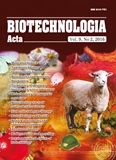ISSN 2410-7751 (Print)
ISSN 2410-776X (on-line)

Ж-л "Biotechnologia Acta" Т. 9, № 2, 2016
https://doi.org/10.15407/biotech9.02.070
P. 70--81, Bibliography. 21, English.
UDC: 57.08:636:31
POSSIBILITY OF COMPUTER EXPERIMENT IN STUDY OF ANIMAL SPERMATOZOA HETEROGENEITY
L. V. Gorbunov, Y. M. Mazharova
National Technical University «Kharkiv Polytechnic Institute», Ukraine
A simulation model for evaluating the survival and fertilizing capacity of animal spermatozoa was developed, taking into account the initial condition of the sperm and the effectiveness of cryopreservation stages. The model is based on an analytical expression that reflects the main reasons for the survival of reproductive cells in onto-, techno- and phylogenesis. The decrease in spermatozoa resistance depends on a number of biological factors — the animal species, physiological conditions of sperm donor and recipient, the ejaculate quality, and technological factors — the effectiveness of the methods of cell cryopreservation and egg insemination. The discrepancy between the results of cell motility obtained by calculation and experimental methods amounted to less than 2% as a result of our own experiments and to less than 5% for the data taken from literature. A feature of the model is the complete independence of the effectiveness of studied techniques from the heterogeneity of animal sperm.
The conducted computer experiment showed that the difference between the values of initial motility and fertilizing capacity of sperm varies from 50 to 100% depending on the difference of biological parameters, while the index of the effectiveness of selected technique creates an error of about 1%. Comparative analysis of alternative technologies of spermatozoa cryopreservation showed the maximum efficiency of the stages of cryoprotectant use, freeze mode, survival and fertilizing capacity of the object. The use of computer modeling allows to greatly reduce the spread in spermatozoa preservation values that were obtained in different experiments, and thus to reduce the time and costs it takes to obtain reliable results.
Key words: system biology, cryopreservation, heterogeneity, spermatozoa.
© Palladin Institute of Biochemistry of National Academy of Sciences of Ukraine, 2016
References
- Gorbunov L. Mathematical modeling of the condition of a depreserved biological object. LAPLAMBERT Academic Publishing. Germany. 2014, 116 p. (In Russian).
- Forero-Gonzalez R. A., Celeghini E. C. C., Raphael C. F., Andrade A. F. C., Bressan F. F., Arruda R. P. Effects of bovine sperm cryopreservation using different freezing techniques and cryoprotective agents on plasma, acrosomal and mitochondrial membranes. Andrologia. 2012, V. 44, P. 154–159. http://dx.doi.org/10.1111/j.1439-0272.2010.01154.x
- Irawan H., Vuthiphandchai V., Nimrat S. The Effect of Extenders, Cryoprotectants and Cryopreservation Methods on Common Carp (Cyprinus Carpio) Sperm. Animal Reproduction Science. 2010, 122 (3–4), 236–243. http://dx.doi.org/10.1016/j.anireprosci.2010.08.017
- Celeghini E. C., Arruda R. P., Andrade A. F., Nascimento J., Raphael C. F., Rodrigues P. H. Effects That Bovine Sperm Cryopreservation Using Two Different Extenders Has on Sperm Membranes and Chromatin. Animal Reproduction Scienc. 2008, 104 (2–4), 119–131. doi:10.1016/j.anireprosci. 2007.02.001.
- Critser, J. K., Mobraoten L. E. Cryopreservation of Murine Spermatozoa. ILAR J. 2000, 41(4), 197–206. http://dx.doi.org/10.1093/ilar.41.4.197
- Pacey, A. A., Tomlinson M. J. The History of Sperm Cryopreservation. Sperm Banking: Theory and Practice. Cambridge, UK: Cambridge UP, 2009.
- Behma A., Behma L. Energy of spermatozoa, as a criterion in forecasting the fertilization ability of sperm. Bіolohіia tvaryn. 2000, 2 (10), 119–124. (In Ukrainian).
- Behma L., Behma A. Methods of sperm quality evaluation in cryopreservation. Naukovyi zbіrnyk. Metodyky naukovykh doslidzhen iz selektsii, henetyky ta biotekhnolohii u tvarynnytstvi. Kyiv. Ahrarna nauka. 2005, P. 161–172. (In Ukrainian).
- Kharkiv technology of aceptic collection and cryopreservation of sperm from sires: guidelines. Redaktor Ostashko F. Kharkiv. 1990, P. 47. (In Russian).
- Bugrov A. Development of theory and practice of sire sperm cryopreservation. M. S. thesis in biological sciences. Kharkov, Ukraina. 1983, P. 19–24. (In Russian).
- Kopeyka E. Guidelines on low-temperature carp sperm preservation. Moskva. 1986, 9 p. (In Russian).
- Tsvetkova L. Methodical manual on sperm cryopreservation of carp, salmon and sturgeon fish species. Moskva:VNIIPRKH. 1997, 11 p. (In Russian).
- Bibenko O. Influence of cryopreservation factors on the genetic apparatus of fish spermatozoa. Ph. D. dissertation in biological sciences. 1993, 16 p. (In Russian).
- Pavlenko B. Results of studying the cryoconvector method of freezing sperm. Mіzhvіdomchyi tematychnyi naukovyi zbirnyk. Rozvedennia і henetyka tvaryn. Іnstytut rozvedennia і henetyky tvaryn. 2002, V. 36, P. 132–133. (In Ukrainian).
- Mishchenko A., Gorbunov L. Accelerated modes of freezing of biological material. LAPLAMBERTAcademic Publishing. Germany. 2014, 136 p. (In Russian).
16. DSTU 3535-97. Native bull sperm. Technical specifications. (In Ukrainian).
- Gerasimov Yu. Fundamentals of fish economy: textbook. Samara: Izdatelstvo «Samarskiy universitet». 2003, 108 p. (In Russian).
- Gorbunov L., Buchackiy L. Cryopreservation of reproductive cells and embryos. Kyiv: Izdatelsko-poligraficheskiy tsentr «Kievskiy universitet». 2005, 325 p. (In Russian).
- Dzyuba B. Activation, reactivation and fertilization ability of white carp spermatozoa after dilution with cryoprotector environment. Problemy kriobiologii i kriomedetsiny. 1997, N. 3, P. 62–63. (In Russian).
- Ginzburg A. Detlaf T. Development of sturgeon fish. The maturation of eggs and embryogenesis. Moskva: Nauka. 1969, 134 p. (In Russian).
- Lakin B. Biometrics. Moskva: Vysshaya shkola. 1990, 254 p. (In Russian).

